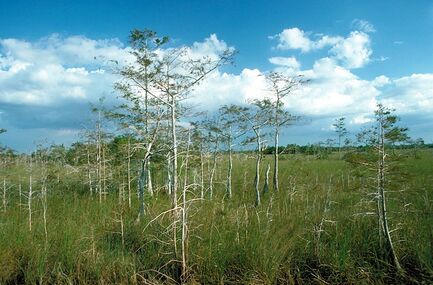Earth:Minerotrophic
Minerotrophic refers to environments that receive nutrients primarily through groundwater that flows through mineral-rich soils or rock,[1] or surface water flowing over land.[2] Minerotrophic, “minerogenous”, and “geogenous” are now often used interchangeably, although the latter two terms refer primarily to hydrological systems, while the former refers to nutrient dynamics.[3] The hydrologic process behind minerotrophic wetlands results in water that has acquired dissolved chemicals which raise the nutrient levels and reduce the acidity.[3] This in turn affects vegetation assemblages and diversity in the wetland in question.[4] If dissolved chemicals include chemical bases such as calcium or magnesium ions, the water is referred to as base-rich and is neutral or alkaline.[3] In contrast to minerotrophic environments, ombrotrophic environments get their water mainly from precipitation, and so are very low in nutrients and more acidic.[5] Of the various wetland types, fens and rich fens are often minerotrophic while poor fens and bogs are often ombrotrophic.[1] Marshes and swamps may also be fed through groundwater sources to a degree.[6]
Hydrology
The hydrological setting of a wetland strongly influences its characteristics.[4] Chemical ions are transported to wetlands via their hydrological system, and in turn affect pH, conductivity, and nutrient levels.[7] Chemical and nutrient dynamics may differ depending on a minerotrophic wetland’s hydrological setting, which could include water discharge dominated, recharge dominated, or some combination of both.[4] These characteristics also vary seasonally, as average groundwater levels increase and decrease at different times of the year.[8] This seasonality can raise water below ground or above the surface to become free standing.[9] Additional factors such as geological conditions, soil type, and surface morphology may also influence the characteristics of a wetland in tandem with hydrological setting.[4]
Vegetation communities
Stable water and nutrient availability via groundwater systems allows for a diverse array of plant species to grow in minerotrophic wetlands.[4] This also allows for peat to accumulate provided the water does not flow too quickly.[4] A minerotrophic wetland may be alkaline or weakly acidic, which also influences vegetation communities.[6] Rich fens are often characterized by alkaline hydrologic conditions, allowing for more plant diversity.[6] These areas may be dominated by brown mosses of the family Amblystegiaceae and sedges in the genus Carex.[6] Acidic poor fens are often dominated by peat mosses of the genus Sphagnum which tend to further increase acidity.[6]
Examples
A notable example of a minerotrophic wetland is the Everglades, a large subtropical wetland located in Western Florida, USA.[10]
See also
References
- ↑ 1.0 1.1 Environment Canada (2014). Ontario wetland evaluation system: Northern Manual, 1st edition, version 3.2. Queen’s printer for Ontario.
- ↑ Wang, Meng; Tian, Jianqing; Bu, Zhaojun; Lamit, Louis J.; Chen, Huai; Zhu, Qiuan; Peng, Changhui (2019-04-01). "Structural and functional differentiation of the microbial community in the surface and subsurface peat of two minerotrophic fens in China" (in en). Plant and Soil 437 (1): 21–40. doi:10.1007/s11104-019-03962-w. ISSN 1573-5036. https://doi.org/10.1007/s11104-019-03962-w.
- ↑ 3.0 3.1 3.2 Rydin, Håkan (2006). The biology of peatlands. J. K. Jeglum, Aljosja Hooijer. Oxford: Oxford University Press. ISBN 978-1-4294-6992-0. OCLC 137237177. https://www.worldcat.org/oclc/137237177.
- ↑ 4.0 4.1 4.2 4.3 4.4 4.5 Brinson, M. M. (1993). A Hydrogeomorphic Classification for Wetlands. Environmental Laboratory (U.S.) & Engineer Research and Development Center (U.S.). Retrieved from https://erdc-library.erdc.dren.mil/jspui/bitstream/11681/6483/1/TR-WRP-DE-4.pdf
- ↑ Pakarinen, P. (1995), "Classification of boreal mires in Finland and Scandinavia: A review", Classification and Inventory of the World’s Wetlands (Dordrecht: Springer Netherlands): pp. 29–38, doi:10.1007/978-94-011-0427-2_4, ISBN 978-94-010-4190-4, http://dx.doi.org/10.1007/978-94-011-0427-2_4, retrieved 2021-03-15
- ↑ 6.0 6.1 6.2 6.3 6.4 Zoltai, S. C.; Vitt, D. H. (1995), "Canadian wetlands: Environmental gradients and classification", Classification and Inventory of the World’s Wetlands (Dordrecht: Springer Netherlands): pp. 131–137, doi:10.1007/978-94-011-0427-2_11, ISBN 978-94-010-4190-4, http://dx.doi.org/10.1007/978-94-011-0427-2_11, retrieved 2021-03-15
- ↑ Vitt, Dale H.; Chee, Wai-Lin (1990). "The relationships of vegetation to surface water chemistry and peat chemistry in fens of Alberta, Canada". Vegetatio 89 (2): 87–106. doi:10.1007/bf00032163. ISSN 0042-3106. http://dx.doi.org/10.1007/bf00032163.
- ↑ Shaffer, Paul W.; Kentula, Mary E.; Gwin, Stephanie E. (1999-09-01). "Characterization of wetland hydrology using hydrogeomorphic classification" (in en). Wetlands 19 (3): 490–504. doi:10.1007/BF03161688. ISSN 1943-6246. https://doi.org/10.1007/BF03161688.
- ↑ Semeniuk, C. A.; Semeniuk, V. (1995), "A geomorphic approach to global classification for inland wetlands", Classification and Inventory of the World’s Wetlands (Dordrecht: Springer Netherlands): pp. 103–124, doi:10.1007/978-94-011-0427-2_9, ISBN 978-94-010-4190-4, http://dx.doi.org/10.1007/978-94-011-0427-2_9, retrieved 2021-03-15
- ↑ Richardson, Curtis J. (2009-08-27). "The Everglades: North America's subtropical wetland". Wetlands Ecology and Management 18 (5): 517–542. doi:10.1007/s11273-009-9156-4. ISSN 0923-4861. http://dx.doi.org/10.1007/s11273-009-9156-4.
 |


